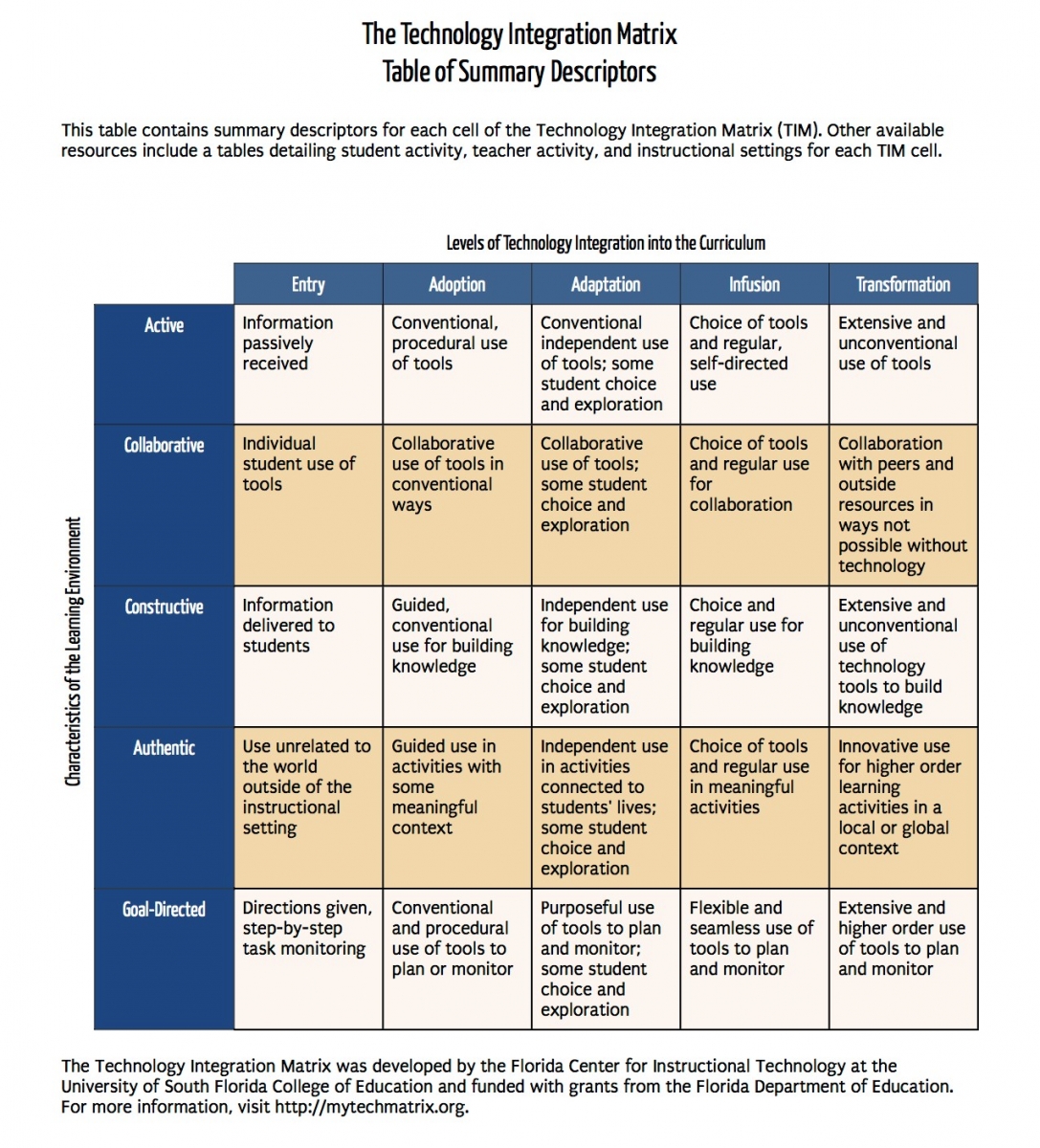Districts around the country are adding technology to their classrooms. But in a world where new hardware and software seems to appear daily, which tools are the best for which grade level? And what’s the best way to use these tools to truly improve teaching and learning? To give schools some guidance, the Florida Center of Instructional Technology (FCIT) has created the Technology Integration Matrix (TIM) to illustrate how teachers can use technology to enhance learning for K-12 students.
Designed to be used as the foundation for technology coaching, the TIM incorporates five interdependent characteristics of meaningful learning environments: active, constructive, goal-directed, authentic, and collaborative. The TIM associates five levels of technology integration (entry, adoption, adaptation, infusion, and transformation) with each of those five characteristics. Together, the five levels of technology integration and the five characteristics of meaningful learning environments create a matrix of 25 cells. (See the figure below)

Although anything containing the word “cells” may sound rigid, Mark Quintana, who uses the TIM with clients as part of his work as a senior education consultant for Promethean, said that’s not the case. The matrix also provides evaluation tools and resources for teachers, and the process of using it varies from school to school. Quintana, whose team has used the matrix with Broward County Public Schools (FL), Fulton County Public Schools (GA), and the Ministry of Education in the Bahamas, said, “We customize the TIM process for different school systems dependent on their desire, among others, for the coaching relationship to be between administrator and teacher, instructional coach and teacher, and/or peer teacher to peer teacher.”
Quintana said that the matrix is not about teaching teachers how to use specific technology products, but rather “about how to use any and all available technology most effectively and efficiently.” At its heart, Quintana adds, “The TIM is about increasing student engagement in the classroom to where the student is at the center of lesson-plan implementation, and the student has choices in both the resources/tools used and the content with which they are interacting.”
The TIM in Action
Autrey Mill Middle School in Alpharetta, Georgia, has used the TIM to help teachers optimize their use of Promethean interactive displays and collaborative learning software, as well as other technology in their classrooms. Principal J.E. “Trey” Martin said that Autrey Mill started using the matrix because “we wanted to support our teachers in a non-threatening way. The TIM provides several samples and videos to help teachers grow. I funded the training of several tech coaches at our school to lead others.”
One of those coaches is Andrea N. Rioux, an instructional technology specialist, who pointed out, “As a school, we have a plethora of technology available to teachers and students. We wanted the technology used in more meaningful ways. The TIM gives us a common language to discuss and implement effective technology integration in the classroom.”
To put the matrix to its best use, Martin said, teachers started with a self-assessment and then created an attainable technology goal that they would aim for—with the support of teacher coaches.
Marisa Wesker, a seventh-grade social studies teacher, is also a peer coach. She said that the TIM has helped her clarify the underlying purpose of all the technology that Autrey Mill provides her. “Just because I teach with technology,” she said, “does not mean it is effective. The TIM helped me re-evaluate how I was using technology during instruction. Now, I use technology to increase collaboration and to build knowledge.”
At its most effective the TIM is not a simple set of steps to follow. It is a catalyst for the kind of re-evaluation that empowers teacher like Wesker, who are always looking to improve their practice. According to Rioux, “The TIM is the main tool we are using this year to help teachers grow their own pedagogy.” After teachers have an observation from a peer coach, Rioux said, they meet to discuss the observation, consider how to improve the technology integration, and determine concrete steps that teachers should take to achieve the technology goals they set at the beginning of the process.
Rioux also uses observation data from the matrix to determine where teachers might need help with specific aspects of classroom tech so that she can focus on those areas in the Technology Discovery workshops she offers on Fridays.
Rioux heartily recommends using the TIM as the basis for a peer-coaching model. At Autrey Mill, she said, “The coaches are excited to mentor and support teachers. Teachers are thriving and using more and more technology through our non-threating and non-evaluating system.”










